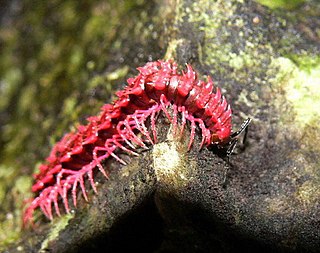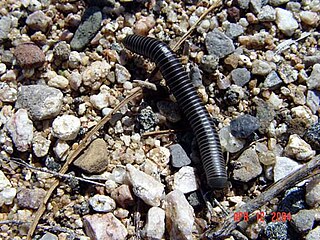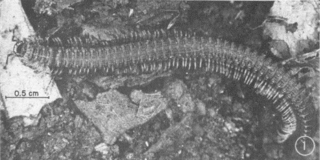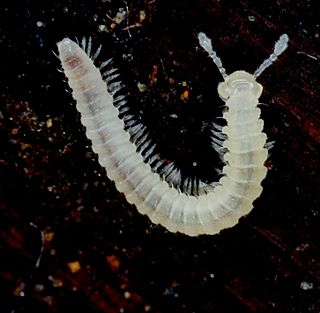
Millipedes are a group of arthropods that are characterised by having two pairs of jointed legs on most body segments; they are known scientifically as the class Diplopoda, the name derived from this feature. Each double-legged segment is a result of two single segments fused together. Most millipedes have very elongated cylindrical or flattened bodies with more than 20 segments, while pill millipedes are shorter and can roll into a tight ball. Although the name "millipede" derives from Latin for "thousand feet", no species was known to have 1,000 or more until the discovery in 2020 of Eumillipes persephone, which can have over 1,300 legs. There are approximately 12,000 named species classified into 16 orders and around 140 families, making Diplopoda the largest class of myriapods, an arthropod group which also includes centipedes and other multi-legged creatures.

Desmoxytes, whose species are commonly known as the dragon millipedes, is a genus of millipedes of the family Paradoxosomatidae found in Southeast Asia. The genus was described by Ralph Vary Chamberlin in 1923, and reviewed by Sergei Golovatch and Henrik Enghoff in 1994. At least 18 species are known from to Malaysia, Myanmar, and Thailand. One species, D. planata, has also been observed in Sri Lanka, the Andaman Islands, Seychelles, Java, Great Coco Island, and Fiji; however, this species has expanded its range by being transported through human activity. Several species have only recently been discovered, and some have yet to be officially described.

Polydesmida is the largest order of millipedes, containing approximately 3,500 species, including all the millipedes reported to produce hydrogen cyanide (HCN). Polydesmids grow and develop through a series of moults, adding segments until they reach a fixed number in the adult stage, which is usually the same for a given sex in a given species, at which point the moulting and the addition of segments and legs stop. This mode of development, known as teloanamorphosis, distinguishes this order from most other orders of millipedes, which usually continue to moult as adults, developing through either euanamorphosis or hemianamorphosis.

Desmoxytes planata, is a species of millipedes in the family Paradoxosomatidae. It is a pantropical species with a vast distribution due to human interference in transportation. It is native to Andaman Islands and introduced to Thailand, the Seychelles, Java, Sri Lanka, Fiji and probably in Malay Peninsula.

Atopetholidae is a family of millipedes in the order Spirobolida. There are about 18 genera and at least 60 described species in Atopetholidae.
Allopocockiidae is a family of millipedes in the order Spirobolida. There are about five genera and eight described species in Allopocockiidae.

Cambalidae is a family of millipedes in the order Spirostreptida. There are at least 20 genera and 80 described species in Cambalidae.

Abacionidae is a family of crested millipedes in the order Callipodida. There are at least three genera and about 13 described species in Abacionidae.
Caseyidae is a family of millipedes in the order Chordeumatida. Adult millipedes in this family have 30 segments. There are about 7 genera and at least 40 described species in Caseyidae.

Conotylidae is a family of millipedes in the order Chordeumatida. Adult millipedes in this family have 30 segments. There are about 19 genera and at least 60 described species in Conotylidae.

Striariidae is a family of millipedes in the order Chordeumatida. Adult millipedes in this family have 30 segments. There are at least 3 genera and about 13 described species in Striariidae.
Tingupidae is a family of millipedes in the order Chordeumatida. Adult millipedes in this family have 28 or 30 segments. There are 2 genera and 13 described species in Tingupidae.
Eurymerodesmidae is a family of flat-backed millipedes in the order Polydesmida. There are at least 2 genera and 30 described species in Eurymerodesmidae.

Euryuridae is a family of flat-backed millipedes in the order Polydesmida. There are at least 4 genera and about 14 described species in Euryuridae.
Macrosternodesmidae is a family of flat-backed millipedes in the order Polydesmida. There are about 9 genera and 16 described species in Macrosternodesmidae.
Sphaeriodesmidae is a family of flat-backed millipedes in the order Polydesmida. There are about 15 genera and at least 90 described species in Sphaeriodesmidae.

Euryurus is a genus of flat-backed millipedes in the family Euryuridae. There are about 14 described species in Euryurus.

Scytonotus is a genus of flat-backed millipedes in the family Polydesmidae. There are about 17 described species in Scytonotus.
Kepolydesmus is a genus of flat-backed millipedes in the family Nearctodesmidae. There are at least four described species in Kepolydesmus.
Rhachodesmidae is a family of flat-backed millipedes in the order Polydesmida. There are more than 20 genera and at least 80 described species in Rhachodesmidae.











